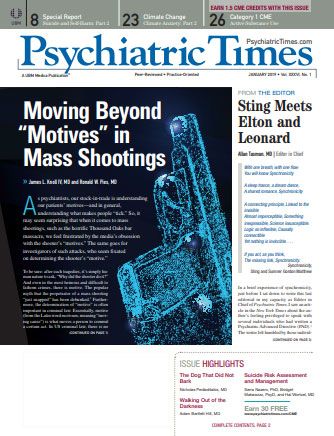Publication
Article
Psychiatric Times
Neutrophil Count Is Associated With Reduced Gray Matter and Enlarged Ventricles in First-Episode Psychosis
Author(s):
Given the evidence for progressive gray matter volume loss in first-episode psychosis, it is possible that leukocyte infiltration may contribute to brain tissue loss.
©deberarr/AdobeStock

SCHIZOPHRENIA
There is evidence for abnormal immune system function in (some) patients with schizophrenia.1 Several studies have found associations between peripheral blood levels of cytokines, small proteins that regulate the inflammatory response, and brain structure.2,3 However, relationships between leukocytes, peripheral immune cells, and brain structural changes have not been investigated, despite evidence that under certain conditions these cells can cross a disrupted blood-brain barrier. Outside of schizophrenia, there is evidence that infiltration of neutrophils into the brain following a stroke is associated with larger infarct volumes and worse outcomes.4 Given the evidence for progressive gray matter volume loss in first-episode psychosis (FEP), it is possible that leukocyte infiltration may contribute to brain tissue loss.5
Nunez and colleagues6 looked at: (1) differences in brain volume and leukocyte counts in patients with FEP and healthy controls, and (2) whether any type of leukocyte was associated with gray matter, white matter, or cerebrospinal fluid in these two groups. The researchers recruited 137 patients with FEP and 81 healthy controls in Spain, aged 13 years or older, with a blood sample, T1 structural brain imaging, and demographic and clinical data. Participants with FEP had an illness duration of less than one year. Exclusion criteria for all participants were intellectual disability (DSM-IV criteria), history of head injury with loss of consciousness, and systemic disease with mental health impact. Additional exclusion criteria for controls were past or present psychotic symptoms or MDD, and having a first-degree relative with a history of psychotic disorder.
A high-resolution T1-weighted structural image was obtained for each participant using one of 5 scanners. Total brain volume was obtained from the sum of gray matter, white matter, and cerebrospinal fluid volumes. Fasting blood samples were collected between 8 and 10 AM at baseline and at 2 months. The median difference between the blood sample and imaging was 15 days for FEP and 17 days for controls. In participants with FEP, psychopathology was assessed using the PANSS (Positive and Negative Syndrome Scale). Cumulative antipsychotic exposure was calculated for subjects with FEP, and data on tobacco and/or cannabis use was obtained for all subjects.
Brain volumes and leukocyte counts were compared between FEP and healthy controls with ANCOVA (analysis of covariance) controlling for age, sex, total brain volume, and years of education where appropriate. The researchers used a backward elimination with bootstrap resampling procedure with gray matter, white matter, and cerebrospinal fluid volumes as dependent variables, and 7 blood cell type counts (neutrophils, eosinophils, basophils, lymphocytes, monocytes, erythrocytes, and platelets), and age, sex, education, total brain volume, antipsychotic medication, tobacco, cannabis, and BMI as predictors. A whole-brain multiple regression voxel-based morphometery analysis was performed on gray matter, including those variables significantly associated with gray matter volume in the model-generating procedure. Third, backward elimination with bootstrap resampling analyses were performed with PANSS total and subscale scores as dependent variables, and the 7 blood cell type counts, and age, sex, education, total brain volume, antipsychotic medication, tobacco, cannabis, and BMI as predictors. Given the exploratory nature of the analyses, the researchers did not correct for multiple comparisons.
Patients with FEP had smaller gray matter volume (including thalamus, entorhinal area, and anterior insula) and larger cerebrospinal fluid volume (including lateral and third ventricles) than controls, but no differences in white matter volumes. Patients with FEP also had significantly higher neutrophils and lower erythrocytes than controls. In FEP, neutrophils were significantly negatively associated with gray matter volume (β=-0.17), and significantly positively associated with cerebrospinal fluid volume (β=0.19). None of the blood cell types were associated with white matter volumes. Higher neutrophils were also associated with greater PANSS total (β=0.17) and positive subscale (β=0.17) scores, including specific items for hallucinations, suspiciousness/persecution, disturbance of volition, and preoccupation. Findings were not confounded by antipsychotic or other psychotropic medication exposure. Importantly, neutrophil counts remained stable 2 years after the initial blood assessment, which argues against an acute infection contributing to these findings. In controls, none of the blood cell counts were associated with gray matter, white matter, or cerebrospinal fluid volumes.
The researchers concluded that theirs is the first study to show associations between blood neutrophil counts, psychopathology, and brain volumes in psychosis. These findings were specific to patients with FEP, who also had higher blood neutrophils than controls. The pattern of reduced gray matter volume was generalized all over the brain rather than localized. Findings further support a role for immune system dysfunction in schizophrenia. Strengths of the study include the relative large sample size, and consideration of multiple potential confounding factors, including antipsychotic medication and acute infection. Limitations of the study include the observational design, use of multiple MRI scanners, blood and imaging were not performed on the same day, and absence of data on anti-inflammatory medications, inflammatory diseases, and sleep problems.
The bottom line
Findings indicate that neutrophil counts are associated with brain volumes and psychopathology in FEP, supporting a role for immune dysfunction in the pathophysiology of this disorder.
This article was originally published on 11/6/18 and has since been updated.
References:
1. Miller BJ, Goldsmith DR. Towards a Schizophrenia Immunophenotype: Progress, Potential Mechanisms, and Future Directions. Neuropsychopharmacol. 2017;42: 299-317.
2. Cannon TD, Chung Y, He G, et al, for the North American Prodrome Longitudinal Study Consortium. Progressive reduction in cortical thickness as psychosis develops: a multisite longitudinal neuroimaging study of youth at elevated clinical risk. Biol Psychiatry. 2015;77:147-157.
3. Fillman SG, Weickert TW, Lenroot RK, et al. Elevated peripheral cytokines characterize a subgroup of people with schizophrenia displaying poor verbal fluency and reduced Broca’s area volume. Mol Psychiatry. 2016;21:1090-1098.
4. Jickling GC, Liu D, Ander BP, et al. Targeting neutrophils in ischemic stroke: translational insights from experimental studies. J Cereb Blood Flow Metab. 2015;35:888-901.
5. Vita A, De Peri L, Deste G, et al. Progressive loss of cortical gray matter in schizophrenia: a meta-analysis and meta-regression of longitudinal MRI studies. Transl Psychiatry. 2012;2:e190.
6. Nunez C, Stephan-Otto C, Usall J, et al. Neutrophil count is associated with reduced gray matter and enlarged ventricles in first-episode psychosis. Schizophr Bull. August 10, 2018; Epub ahead of print.






